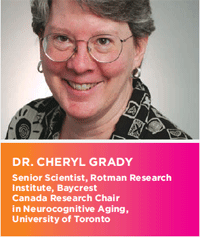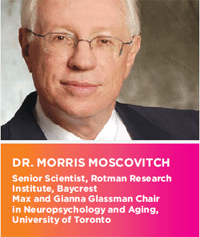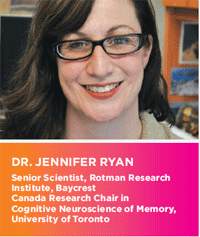Research Excellence
Research Excellence
 In 2010, Dr. Cheryl Grady continued Baycrest’s tradition of excellence in research. The main focus of her current work is “cognitive aging” – specifically, how aging affects brain activity during cognitive tasks and how these differences may affect behaviour.
In 2010, Dr. Cheryl Grady continued Baycrest’s tradition of excellence in research. The main focus of her current work is “cognitive aging” – specifically, how aging affects brain activity during cognitive tasks and how these differences may affect behaviour.
Over the past 14 years, Dr. Grady’s research has spanned many areas, from how our ability to recall faces changes with aging to how neural networks function across time. She has also explored how aging affects our ability to “process” and recognize faces and also what effects lifelong experiences such as bilingualism have on the brain.
Another research focus has been on “social cognition” – how people process social information, especially its encoding, storage, retrieval, and application to social situations. Recent studies have found that brain injury and illness (particularly if they affect the frontal lobes) can adversely affect people’s social judgements and how they interact with others. Problems in this area are often the trigger for moving a person into a long-term care setting.
One of Dr. Grady’s more recent interests is the variability of brain activity which is reduced in older adults and has been linked to poorer and less stable performance on memory tests. “We hope our findings will allow us to design better methods of rehabilitation by identifying the brain mechanisms underlying behavioural difficulties in older adults,” she says.
In 2010, one of Dr. Grady’s papers, reporting on a project exploring large-scale brain network activity in older adults, won the Donald T. Stuss Award for Research Excellence.
 When Dr. Morris Moscovitch first started doing research at Baycrest in the late 1980s, the Rotman Research Institute didn’t exist. “The early days were challenging,” he recalls. “But we had great leaders like Dr. Don Stuss and Dr. Morris Freedman who were eventually able to attract excellent scientists to join us. With the support of Joe Rotman and Baycrest, we soon had the feeling that we were actually leading the field.”
When Dr. Morris Moscovitch first started doing research at Baycrest in the late 1980s, the Rotman Research Institute didn’t exist. “The early days were challenging,” he recalls. “But we had great leaders like Dr. Don Stuss and Dr. Morris Freedman who were eventually able to attract excellent scientists to join us. With the support of Joe Rotman and Baycrest, we soon had the feeling that we were actually leading the field.”
Over the past 25 years, Dr. Moscovitch has built an impressive body of research in the areas of memory, attention, and face-recognition. He currently heads the University of Toronto’s Human Neuropsychology and Cognitive Science Lab where scientists study neurologically normal people and those with brain damage related to stroke, head injury and Alzheimer’s disease.
Dr. Moscovitch is known spe¬cifically for his work on the frontal lobes and a brain structure called the hippocampus which is likely involved in memory and attention. He is currently conducting research on face and object recognition in young and old adults and in people with specific brain injuries that selectively affect their ability to recognize faces, objects or words. “The goal is to figure out what distinguishes the perception of one kind of material from another,” he explains.
Dr. Moscovitch currently sits on the editorial boards of prominent research journals including Neuropsycho-logia, Cortex, Cognitive Neuro-psychology, and Brain Research.
 Dr. Jennifer Ryan is studying memory performance in younger and older adults, using specialized equipment to track eye move¬ments. While others have studied eye movement to examine atten¬tion, Dr. Ryan believes she and her colleagues are the first to use it as a tool to explore memory.
Dr. Jennifer Ryan is studying memory performance in younger and older adults, using specialized equipment to track eye move¬ments. While others have studied eye movement to examine atten¬tion, Dr. Ryan believes she and her colleagues are the first to use it as a tool to explore memory.
She explains that different regions of the brain work together to support different kinds of memory. For instance, one area is responsible for taking in information about faces or objects and associating them with names. Another part of the brain helps us remember how to perform motor tasks, like riding a bike or knitting a scarf.
“I’m interested in looking at how different neural systems cooperate to support memory – and how they break down when there is cognitive impairment,” Dr. Ryan explains.
To carry out her research, Ryan uses eye-movement monitoring, a technique taken from psychology, and an imaging technique called magnetoencephalography (MEG that measures the magnetic fields produced by electrical activity in the brain.
She is one of the first scientists to combine these technologies and believes that doing so will yield original and useful information. “Eye-movement monitoring is based on the idea that our eyes are attracted to areas of the environment that have changed,” she explains. “MEG allows us to look at which regions of the brain are ‘on’ while the subject is asked to think about or remember something. We can then associate different kinds of memory and certain areas of the brain.”
In one study published in 2010, Dr. Ryan and her colleagues noted eye movements that occurred when people were shown a never-before-seen image on a computer screen and compared them to eye movements that occurred when the same people were shown an image they had seen previously. “We were also able to pick up subtle changes in eye movements when subjects were shown an image identical to one they had seen before – a horse standing in a pasture – and then shown a very similar image but with an altered detail – the same horse wearing a saddle,” she explains.
Dr. Ryan believes that studying how memory systems work may improve our understanding of how memory is organized more generally and lead to better methods for helping people with memory deficits due to aging, injury and illnesses.
Privacy Statement | Disclaimer
© 2011 Baycrest. All Rights Reserved.